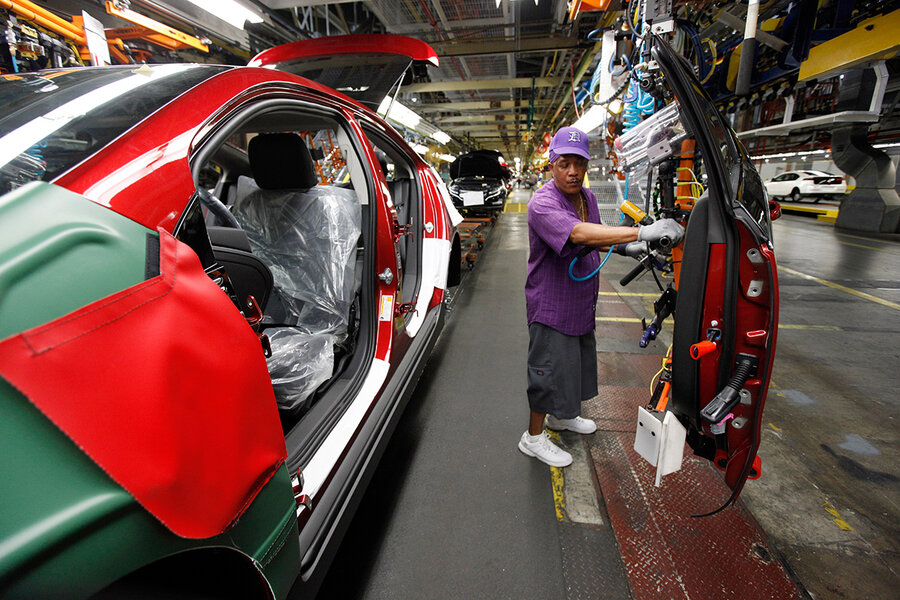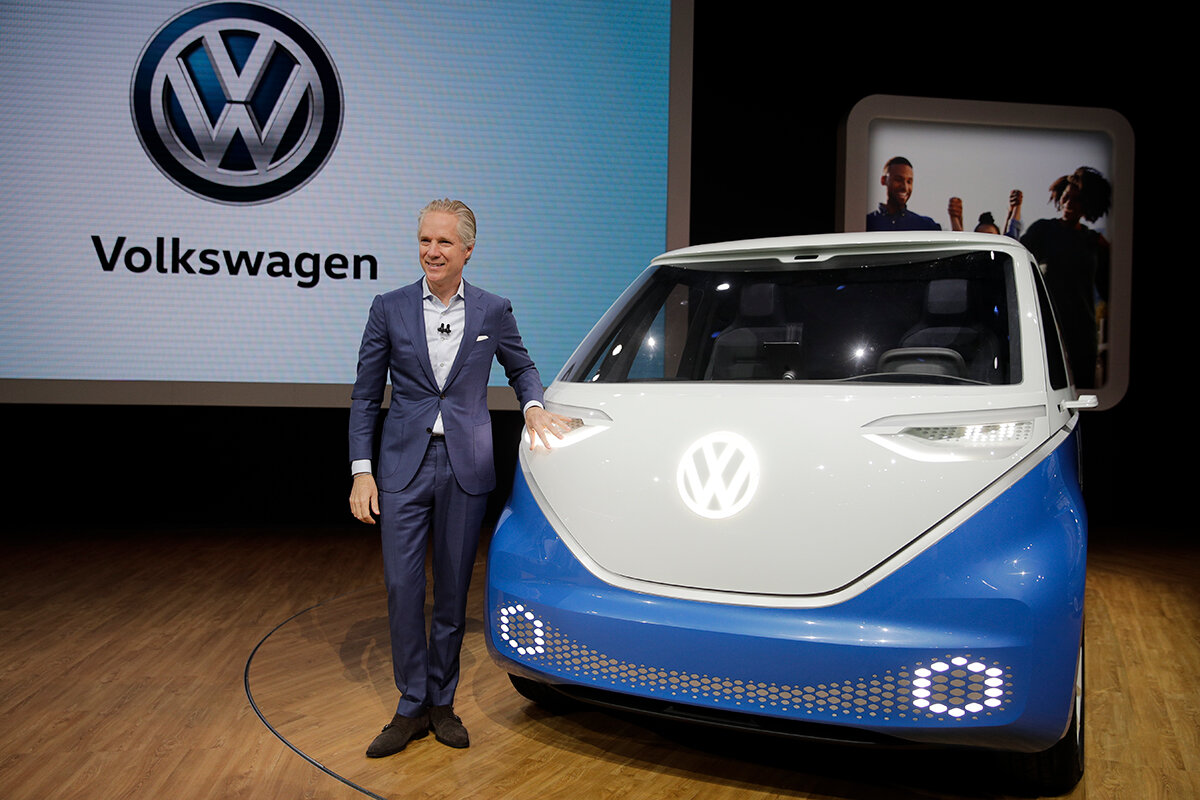Which fork in the road to take? Detroit says both.
Loading...
Consider the quandary of Volkswagen’s new US chief executive.
The division will be selling a new $30,000 to $40,000 electric car in 2020, the first in a long line of promised electric vehicles. But EVs aren’t profitable and make up only a tiny share of auto sales. So what can he sell – and make money with – until EV technology gets cheaper and sales take off?
How about a pickup?
Why We Wrote This
The GM cutbacks story is a piece of something bigger – and a bit of a paradox. Big SUVs and pickups might just fund automakers’ electric, self-driving future.
"It’s something we should look at," CEO Scott Keogh told reporters during a preview of the Los Angeles Auto Show, which opened to the public Friday.
Fiat Chrysler Automobiles is also going the electric route with 30 models, including a plug-in hybrid Jeep Renegade, which may or may not be sold in the United States. But what is Jeep’s biggest splash at the auto show? The Gladiator, its first new pickup in 26 years.
Having hit a technological and economic fork in the road, the auto industry appears to have decided to take both paths forward. One involves bigger and more powerful SUVs and pickups, like the Gladiator, which are expected to allow the companies to pile up profits over the next decade or so.
That money will be needed for the road less traveled. The industry is building technology and expertise to create EVs and autonomous vehicles (AVs), which are expected to represent the future.
There’s just one problem. Both roads forward look rough and bumpy. There's no guarantee consumers will want EVs or fully autonomous vehicles. And counting on fat profits looks iffy with the industry facing a union contract negotiation next year and the prospect of more auto-related tariffs and an economy that might just go bust.
“We don't see a cliff,” says Michelle Krebs, executive auto analyst for Autotrader, a car-shopping website. Instead, she foresees a slow decline, with sales of just over 17 million vehicles for 2018, down from the record 17.8 million set in 2016. (November car sales will be released Monday.)
But “if we get in a trade war, and big tariffs are applied to imported vehicles and imported car parts, then all bets are off,” she adds.
After a near-death in the Great Recession that required government bailouts for General Motors and Chrysler, the US auto industry has been on a tear. Sales rose steadily through 2016. Since then, sales have softened a little. Now, the industry faces a host of looming political, technological, and consumer challenges, which signal tougher times ahead.
One of the biggest challenges is political. A trade war – levied either against Europe or China or both – could be devastating for the US industry. The Trump administration has threatened to impose 25 percent tariffs on imports of cars to the US, raising car prices for consumers coming from Europe, South Korea, and Japan.
Separately, the White House has imposed a 10 percent tariff on car parts made in China, which President Trump is threatening to increase to 25 percent on Jan. 1. The administration hopes to convince foreign companies to build cars in the US, but it would take a few years for the factories to be built and auto jobs created.
More job cuts expected
Until then, however, the tariffs are likely to reduce auto jobs. The 25 percent duty on autos and auto parts would raise car prices by an average $2,450, reduce annual sales by 1.2 million, and cut US auto-related employment by nearly 200,000, according to the Center for Automotive Research in Ann Arbor, Mich.
Such massive job cuts would complicate the industry’s negotiations with the United Autoworkers, whose contract expires next September.
“The concern going into the 2019 negotiations will be largely maintaining jobs,” says Marick Masters, a labor expert at Wayne State University. “With the whole restructuring of the companies … the union is going to be very concerned about product placement, investments in plants in the US, and also how they might take advantage of the move toward electrification and ensure that their workforce is trained to perform those types of jobs.”
Another trend: Americans increasingly prefer pickups, SUVs, and crossovers to passenger cars. That’s good news for US carmakers, because they make more money with the former than with the latter.
Already automakers are trying to realign themselves. On Monday, General Motors announced it would be cutting 14,200 jobs and closing factories in order to pay for a transition to EVs and AVs and prepare for slower sales. The mothballed factories include the Hamtramck, Mich., and Lordstown, Ohio, car-assembly plants, where workers have endured previous downturns.
The move earned an angry tweet from Mr. Trump: ''The U.S. saved General Motors, and this is the THANKS we get!”
Two days later, Ford announced it was eliminating shifts at two factories in order to increase production of its popular Expedition and Lincoln Navigator SUVs. For both automakers, it’s an uncertain future.
EVs' small market share
For example: The industry is pursuing Tesla by committing to EVs in a big way, even though there are no guarantees that customers will buy them. Currently, all-electric vehicles account for some 1 percent of annual auto sales. Navigant Research predicts global sales will grow sixfold through 2025. But that will still account for a small share of the overall market, and much of that growth may come from China, which is heavily subsidizing EVs.
“The gasoline engine will be dominant for at least 10 years or more,” says Ms. Krebs of Autotrader. “All those alternative-propulsion systems are extremely expensive [to develop]. Automakers are not going to be making money on them” anytime soon.
Another uncertainty: autonomous vehicles. The industry has partnered with Silicon Valley firms to create cars that drive themselves. But in March, a self-driving Uber car in Tempe, Ariz., hit and killed a woman.
Since then, consumer skepticism about the technology has grown. In a May survey of 1,250 people, Cox Automotive found that autonomous driving appealed to only 17 percent, compared with 30 percent two years ago. Nearly half said they would never buy a fully autonomous car.
The industry’s challenge with both AVs and EVs will be to take the niche interest and grow it into mainstream appeal.






